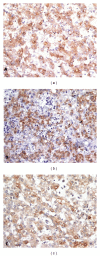Interleukin-6 and C-reactive protein are overexpressed in the liver of perinatal deaths diagnosed with fetal inflammatory response syndrome
- PMID: 24659848
- PMCID: PMC3934536
- DOI: 10.1155/2014/252780
Interleukin-6 and C-reactive protein are overexpressed in the liver of perinatal deaths diagnosed with fetal inflammatory response syndrome
Abstract
Anatomopathologic studies have failed to define the fetal inflammatory response syndrome (FIRS) as a cause of fetal death. Here, liver fragments of perinatal autopsies were collected at a university hospital from 1990 to 2009 and classified according to the cause of death, perinatal stress, and gestational age (GA) of the fetus. IL-6, TNF-α, and C-reactive protein (CRP) expression were immunostained, respectively, with primary antibody. Cases with congenital malformation, ascending infection, and perinatal anoxia showed increased IL-6, CRP, and TNF-α, respectively. Prematures presented higher expression of IL-6 whereas term births showed higher expression of CRP. Cases classified as acute stress presented higher expression of IL-6 and TNF-α and cases with chronic stress presented higher expression of CRP. GA correlated negatively with IL-6 and positively with CRP and TNF-α. Body weight correlated negatively with IL-6 and positively with CRP and TNF-α. Despite the diagnosis of FIRS being clinical and based on serum parameters, the findings in the current study allow the inference of FIRS diagnosis in the autopsied infants, based on an in situ liver analysis of these markers.
Figures


Similar articles
-
Association between the markers of FIRS and the morphologic alterations in the liver of neonates autopsied in the perinatal period.Fetal Pediatr Pathol. 2013 Feb;31(1):48-54. doi: 10.3109/15513815.2012.659536. Epub 2012 Apr 19. Fetal Pediatr Pathol. 2013. PMID: 22515549
-
Significance of C-reactive protein in predicting fetal inflammatory response syndrome.Ginekol Pol. 2015 Dec;86(12):926-31. Ginekol Pol. 2015. PMID: 26995943
-
Role of umbilical interleukin-6, procalcitonin and C-reactive protein measurement in the diagnosis of fetal inflammatory response syndrome.Ceska Gynekol. 2021;86(2):80-85. doi: 10.48095/cccg202180. Ceska Gynekol. 2021. PMID: 34020553 English.
-
Therapeutic interventions for fetal inflammatory response syndrome (FIRS).Semin Fetal Neonatal Med. 2020 Aug;25(4):101112. doi: 10.1016/j.siny.2020.101112. Epub 2020 Apr 11. Semin Fetal Neonatal Med. 2020. PMID: 32303464 Review.
-
Peripheral levels of C-reactive protein, tumor necrosis factor-α, interleukin-6, and interleukin-1β across the mood spectrum in bipolar disorder: A meta-analysis of mean differences and variability.Brain Behav Immun. 2021 Oct;97:193-203. doi: 10.1016/j.bbi.2021.07.014. Epub 2021 Jul 28. Brain Behav Immun. 2021. PMID: 34332041
Cited by
-
Evaluation of related factors, prediction and treatment drugs of no-reflow phenomenon in patients with acute ST-segment elevation myocardial infarction after direct PCI.Exp Ther Med. 2018 Apr;15(4):3940-3946. doi: 10.3892/etm.2018.5900. Epub 2018 Feb 27. Exp Ther Med. 2018. PMID: 29563988 Free PMC article.
-
Neonatal sepsis and inflammatory mediators.Mediators Inflamm. 2014;2014:269681. doi: 10.1155/2014/269681. Epub 2014 Dec 30. Mediators Inflamm. 2014. PMID: 25614712 Free PMC article. Review.
-
Diagnostic Value of Umbilical Cord Blood Interleukin-6 Level in Premature Infants with Early-Onset Sepsis.Children (Basel). 2025 Feb 27;12(3):301. doi: 10.3390/children12030301. Children (Basel). 2025. PMID: 40150583 Free PMC article.
References
-
- Bracci R. Acute phase reaction in the fetus and newborn. Acta Paediatrica. 2000;89(9):1027–1029. - PubMed
-
- Goepfert AR, Andrews WW, Carlo W, et al. Umbilical cord plasma interleukin-6 concentrations in preterm infants and risk of neonatal morbidity. American Journal of Obstetrics and Gynecology. 2004;191(4):1375–1381. - PubMed
-
- David H. The hepatocyte. Development, differentiation, and ageing. Experimental Pathology, Supplement . 1985;11:1–148. - PubMed
-
- Arai H, Noguchi A, Goto R, Matsuda T, Nakajima H, Takahashi T. Liver fibrosis in an extremely small infant for gestational age. Tohoku Journal of Experimental Medicine. 2010;221(3):181–185. - PubMed
Publication types
MeSH terms
Substances
LinkOut - more resources
Full Text Sources
Other Literature Sources
Medical
Research Materials
Miscellaneous

